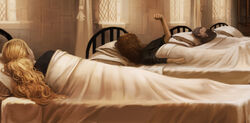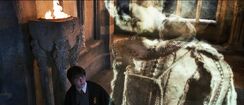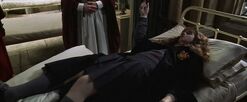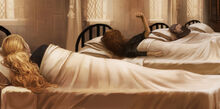mNo edit summary Tag: Visual edit |
mNo edit summary Tag: Visual edit |
||
| Line 33: | Line 33: | ||
|- |
|- |
||
|[[Hermione Granger]] |
|[[Hermione Granger]] |
||
| − | |Saw the basilisk in Penelope's mirror, while near the Hogwarts library.[[File:Petrified Hermione.jpg|247x247px|thumb|left]] |
+ | |Saw the basilisk in Penelope's mirror, while near the Hogwarts library.<br />[[File:Petrified Hermione.jpg|247x247px|thumb|left]] |
|- |
|- |
||
|[[Penelope Clearwater]] |
|[[Penelope Clearwater]] |
||
Revision as of 20:58, 20 July 2019

Victims of Petrification turned to stone
- "Dark Magic of the most advanced kind."
- — Albus Dumbledore regarding petrification[src]
Petrification is a malign magical state in which a creature is immobile and unresponsive, as if they had been turned to stone. It is a phenomenon of the most advanced Dark Magic, affecting beasts, beings and even spirits such as ghosts.[1] Petrification can be inflicted by the Statue curse and the gazes of the Gorgon and the Basilisk. In the case of the Basilisk, its gaze ordinarily kills living creatures, but when seen indirectly, or by a ghost, it instead causes petrification. Methods for wizards to inflict petrification may also exist.
History
During the history of Hogwarts School of Witchcraft and Wizardry, the Chamber of Secrets was opened twice, and in both cases the Serpent of Slytherin was released and attacked the populace. The first opening in 1943 resulted in the petrification of three students, and the death of one, Myrtle Warren. The second opening in 1992 led to the petrification of students Colin Creevey, Justin Finch-Fletchley, Hermione Granger and Penelope Clearwater, along with cat Mrs Norris and ghost Sir Nicholas de Mimsy-Porpington.[1]
Effects
Victims of petrification are completely paralysed and unresponsive. It may take careful examination to discern if a victim is petrified. A petrified ghost will turn a dark smoky grey and can only be moved using air currents. Petrification can be remedied with the use of a Mandrake Restorative Draught.
Petrification should not be confused with the Full Body-Bind Curse or the Hardening Charm. The Full Body-Bind Curse is temporary and can be lifted easily, while the Hardening Charm turns an object to literal stone. Gilderoy Lockhart once confused the effects of petrification with those of the Transmogrifian Torture; however, the truth of his claims are dubious.[1]
Known victims
- "The basilisk kills people by looking at them. But no one’s died — because no one looked it straight in the eye. Colin saw it through his camera. The basilisk burned up all the film inside it, but Colin just got Petrified. Justin... Justin must’ve seen the basilisk through Nearly Headless Nick! Nick got the full blast of it, but he couldn’t die again... and Hermione and that Ravenclaw prefect were found with a mirror next to them. Hermione had just realised the monster was a basilisk."
- — The known victims of petrification[src]
| Victim | Circumstances |
|---|---|
| Mrs Norris | Saw the basilisk's reflection in the water on the floor. |
| Colin Creevey | Saw the basilisk through his camera; the basilisk's gaze also burned his camera's film to a crisp. |
| Nicholas de Mimsy-Porpington | Saw the basilisk directly, but as a ghost he could not die again. |
| Justin Finch-Fletchley | Saw the basilisk through Nick, who was transparent, did not see the basilisk directly. |
| Hermione Granger | Saw the basilisk in Penelope's mirror, while near the Hogwarts library. |
| Penelope Clearwater | Saw the basilisk in her mirror. Penelope is furthest on the left |
| Students of Hogwarts (1943) | During the incident of the first unleashing of the beast in 1943, three unnamed Hogwarts students were petrified. |
Etymology
The Latin verb petrificare means "to make into stone", from the Latin word for "rock", petra.
Behind the scenes
- It is unknown how Nearly Headless Nick was revived from being petrified, because, as a ghost, he presumably would not have been able to consume the antidote. (However, as petrified humans cannot consume potions either, being unconscious, perhaps the antidote is administered in a way that could also revive ghosts.)
- In mythology, petrification is associated with Medusa the Gorgon and the cockatrice as well as the basilisk. In Cornish folklore, petrification legends explain the origin of prehistoric megalithic monuments, such as the Merry Maidens stone circle.[2]
- It's likely that there is an advanced dark spell that induces petrification, as Dumbledore states that no second year could've caused it rather than no wizard. Assuming that this is true it's unknown what the incantation is for said spell.
Appearances
- Harry Potter and the Chamber of Secrets (First appearance)
- Harry Potter and the Chamber of Secrets (film)
- Harry Potter and the Chamber of Secrets (video game)
- Harry Potter: A Pop-Up Book (Mentioned only)
- Harry Potter Trading Card Game
- Pottermore
- Wonderbook: Book of Spells
- Harry Potter: The Creature Vault (Mentioned only)
- Harry Potter: Hogwarts Mystery
